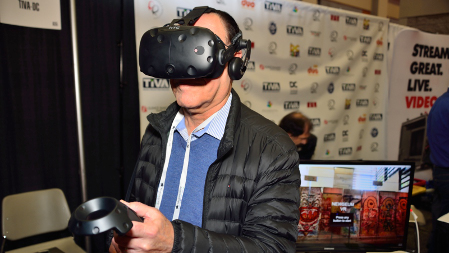2017 GV Expo Day Two Goes Beyond Government
WASHINGTON—While the Government Video Expo & National Drone Show is ostensibly the place government entities from federal to local levels attend to seek technologies and information to help them do more with audio and video, the show also taps attendees of all sizes from the metro Washington, D.C., region and beyond.

Robert Suslowitz of Port Communications tries on a VR headset at the Television Internet & Video Association. (Credit Ross Stansfield www.rsprod.com)
The AV needs of big players like FEMA, DoD or the IRS are of a different magnitude than a small production house, but some common themes exist. One is data: Everybody is producing more of it and trying to figure out the best way to effectively manage it.
Quantum was on the show floor to take storage and workflow queries from a variety of potential clients, said Keith Lissa, senior director, M&E Solutions Marketing. He noted that while Quantum has a significant amount of ‘federal’ business, the exhibition also attracted representatives from the many educational institutions located in the D.C. area, as well a lot of small and mid-sized regional production companies.
“Producers of all sizes are having to shoot more and more in higher resolution, producing bigger files,” said Lissa. “Add in evolving collaborative workflows and the need for better, smarter storage is only increasing.
Lissa said that Quantum’s recently-introduced Xcellis Foundation product was on display and perfect for many smaller to mid-sized needs. It’s billed as an affordable, easy-to-use scalable NAS storage appliance, and like established offerings, it benefits from Quantum’s StorNext platform in workflow and collaboration terms.
CUTTING EDGE
The professional video industry's #1 source for news, trends and product and tech information. Sign up below.
Storage and workflow improvement is one of the critical needs of every modern, digital media enterprise. On day two of GV Expo, a bit of technology that in many cases is more potentially interesting had a show floor presence: The nearby University of Maryland’s Virtual Reality Club had a multi-station demo that drew attention from people with more curiosity than real plans and also a few attendees who really saw VR/AR applications in the near future.
Harrison Linowes, UMD VR Club president, said that the computer science department at UMD was working on a variety of VR/AR projects across navigation, medical training, virtual manufacturing, immersive education and more.
“Gaming is of course the low hanging fruit here,” said Linowes. “But there are all sorts of developing applications in many industries.”
One example he has recently been involved with was a disaster training exercise at the nearby National Institutes of Health.
Galen Stetsyuk, founder of MPLEX Game Developer Studio and the founder of the UMD VR Club, said it was still early days for the technology: “It’s pretty new in gaming and very new in applications outside gaming … but almost everyone is interested and we’ve had attention from people interested in training and defence applications.”
One example of an attendee seeing a real application for VR/AR was Robert Suslowitz, president of Port Communications, a metro-DC production company that also sets up remotely operated and portable video streaming systems for a large religious institution. Notably, the company develops training programs for volunteer streamers.
While Suslowitz attended GV Expo to look at a variety of traditional hardware, including cameras and switchers, and was determining the best way to add UAV to his portfolio in the flight-restricted area around Washington, D.C. He saw a potential VR business after seeing both the UMD demo and strapping on a headset at the Television Internet & Video Association.
“After seeing these demos, I want to develop some training tapes for firemen and paramedics. I can see that as being a real benefit,” Suslowitz said
See also:
GV Expo: CTA Offers Look Into Virtual Future
GV Expo: Breaking Down Virtual reality Barriers
GV Expo: Saving Our Audiovisual History for Future Generations

